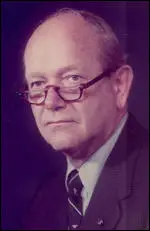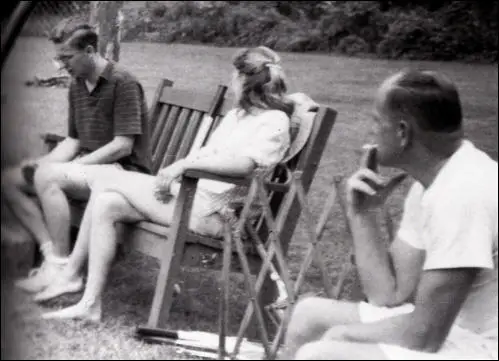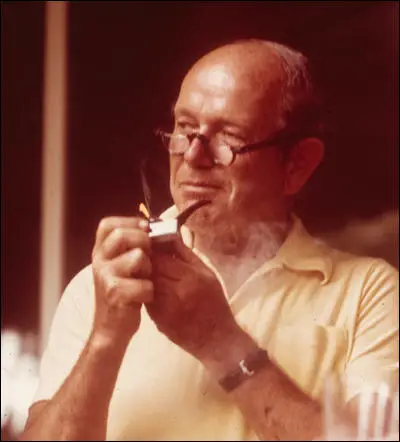Wistar Janney

Frederick Wistar Janney, was the youngest son of Walter Coggeshall Janney, was born in Bryn Mawr, on 15th March, 1919. Nicknamed “Wistar,” he was the youngest of six children of Walter Coggeshall Janney and Pauline Flower Morris. "The Janney family had a large estate in Bryn Mawr. Walter Janney was a prominent and very successful Philadelphia investment banker. In the early 1920s, he built a second summer estate on Cape Cod near Woods Hole, Massachusetts for his family. The entire extended Janney family has summered there ever since. Their love of sailing, in particular, has engendered a number of family boats and the estate remains today a stronghold of family reunion and connection." (1)
Wistar Janney was educated at the Fessenden School in West Newton and Phillips Exeter Academy. After graduating in 1937 he went on to Princeton University where he completed his undergraduate education with a major in Politics in June 1941. After watching the film Flight Command staring Robert Taylor, he enlisted in the Naval Air Corp. Janney trained as a naval aviator at the Corpus Christie Naval Air Station in Texas. He married his summer sweetheart Mary Draper of Brooklyn in January 1944
During the Second World War Wistar Janney was assigned to Torpedo Squadron 13 (VT-13) on the USS Aircraft Carrier Benjamin Franklin (CV-13). He piloted a Grumman Avenger torpedo bomber and took part in the Battle of Leyte Gulf in October 1944. "The last, largest and finally decisive naval battle between the US Fleets in the Pacific and the Japanese Combined Fleet." (2) As the Flight/ Executive Officer he led the squadron into the battle. "In directing his command for the infliction of extensive damage on the enemy in this decisive conflict, he personally scored a direct bombing hit on a Japanese aircraft carrier. For his superb skill as a pilot and brilliant combat tactics throughout this engagement, he was awarded the Navy Cross, second only to the Congressional Medal of Honor." (3)
After the war Wistar and Mary Janney studied at Yale University. Mary in sociology and Wistar in the newly formed Program in Russian Area Studies where they both received the Master of Arts degree in 1948. The following year he joined the Central Intelligence Agency. "Wistar Janney was part of an idealistic group of World War II veterans that never again wanted to see the possibility of a world at war. A strong, centralized post-World War II intelligence apparatus seemed like an almost ideal solution, and a good career for a group of men who were already, by birth, financially well endowed and secure. In the aftermath of World War II, America had come out on top. They wanted to keep it that way." (4)
Central Intelligence Agency
Wistar and his wife Mary Drapper Janney moved to Georgetown where their friends included Mary Pinchot Meyer, Cord Meyer, James Jesus Angleton, Cicely Angleton, Philip Graham, Katharine Graham, Ben Bradlee, Antoinette Pinchot Bradlee, James Truitt and Anne Truitt. According to Nina Burleigh, the author of A Very Private Woman (1998): "Mary Draper Janney, a dark-eyed historian who taught at a private suburban Washington day school, had attended Vassar with Mary. She retained her 1940s style into the 1960s, even though she was married and the mother of two children, and her students thought of her as a capital-city version of Lauren Becall." (5)

The Janneys mainly associated with journalists, CIA officers and government officials. Peter Janney remembers spending time with Mary Pinchot Meyer and Cord Meyer: "Our families were socially entwined - we went camping together, played touch football, visited each other's homes frequently. The Meyers had three children: Quentin, Michael, and Mark. Michael and I had been born less than one month apart, and Quentin... was a year and a half older. Mark and my brother, Christopher, were the same age, about two years younger than Michael and I. By the time Michael and I were seven, we were best friends, and often inseparable. We shared a number of bonds, especially baseball and fishing." (6)
Nina Burleigh has pointed out: "The younger families - the Meyers, Janneys, Truitts, Pittmans, Lanahans, and Angletons - spent a great deal of leisure time together. There were evening get-togethers, and sometimes the families took weekend camping trips to nearby beaches or mountains when husbands could get away... On Saturday mornings in the fall, the adults got together and played touch football in a park north of Georgetown while their children biked around the sidelines, then all retired to someone's house for lunch and drinks... The Janneys had a pool, and on hot summer nights the parties were aloud, drunken affairs, filled with laughter, dancing, and the sound of breaking glass and people being pushed into the pool." (7)
(If you find this article useful, please feel free to share. You can follow John Simkin on Twitter and Google+ or subscribe to our monthly newsletter)
Ben Bradlee recalls in his autobiography, The Good Life (1995) that he was also part of the same group. "Socially our crowd consisted of young couples, around thirty years old, with young kids, being raised without help by their mothers, and without many financial resources. The Janneys - Mary and Wistar, who worked for the CIA; the Winships - Leibe and Tom who worked for Senator Lev Saltonstall of Massachusetts." (8)

Wistar Janney developed a dislike of Mary Pinchot Meyer: "Wistar himself was never fond of Mary, particularly after she jettisoned Cord, devastating him, by all accounts. Moreover, what infuriated Wistar even more was the fact that over the years Mary had become increasingly outspoken about her displeasure with what the CIA was doing in the world. No other CIA wife had ever dared such public bluntness, certainly not Wistar's. But that hadn't stopped Mary Meyer, even if my father's well-oiled temper might be the kind of assault any civilized person would want to avoid." (9)
Initially Wistar began working in the Office of Current Intelligence (OCI) under Sheldon White. Later on, Janney worked at the CIA's new Science & Technology directorate (DS&T). By 1963, he had become Chief of the Sino-Soviet Bloc Area, according to Victor Marchetti who worked for him at this time. His son, Peter Janney, has claimed: "There are also indications that for several years Wistar may have been involved in a number of CIA covert operations." (10)
Murder of Mary Pinchot Meyer
On 12th October, 1964, Mary Pinchot Meyer was shot dead as she walked along the Chesapeake and Ohio towpath in Georgetown. Henry Wiggins, a car mechanic, was working on a vehicle on Canal Road, when he heard a woman shout out: "Someone help me, someone help me". He then heard two gunshots. Wiggins ran to the edge of the wall overlooking the towpath. He later told police he saw "a black man in a light jacket, dark slacks, and a dark cap standing over the body of a white woman." (11)
Mary appeared to be killed by a professional hitman. The first bullet was fired at the back of the head. She did not die straight away. A second shot was fired into the heart. The evidence suggests that in both cases, the gun was virtually touching Mary’s body when it was fired. As the FBI expert testified, the “dark haloes on the skin around both entry wounds suggested they had been fired at close-range, possibly point-blank”. (12)

Ben Bradlee points out that the first he heard of the death of Mary Pinchot Meyer was when he received a phone-call from Wistar Janney: "My friend Wistar Janney called to ask if I had been listening to the radio. It was just after lunch, and of course I had not. Next he asked if I knew where Mary was, and of course I didn't. Someone had been murdered on the towpath, he said, and from the radio description it sounded like Mary. I raced home. Tony was coping by worrying about children, hers and Mary's, and about her mother, who was seventy-one years old, living alone in New York. We asked Anne Chamberlin, Mary's college roommate, to go to New York and bring Ruth to us. When Ann was well on her way, I was delegated to break the news to Ruth on the telephone. I can't remember that conversation. I was so scared for her, for my family, and for what was happening to our world. Next, the police told us, someone would have to identify Mary's body in the morgue, and since Mary and her husband, Cord Meyer, were separated, I drew that straw too." (13)
Wistar Janney and the CIA Coverup
Peter Janney, the author of Mary's Mosaic (2012) has questioned this account of events provided by Bradlee. "How could Bradlee's CIA friend have known 'just after lunch' that the murdered woman was Mary Meyer when the victim's identity was still unknown to police? Did the caller wonder if the woman was Mary, or did he know it, and if so, how? This distinction is critical, and it goes to the heart of the mystery surrounding Mary Meyer's murder." (14) According to Bradlee, Mary's identity hadn't been established officially until he had identified her in the morgue "sometime after six o'clock in the evening".
Peter Janney was away at boarding school at the time but later he talked to his brother about the events that day. "Christopher recalled that during dinner there had been absolutely no mention of Mary Meyer's murder. But sometime after dinner, 'it had to be quarter to eight, if not eight, Dad was sitting at his desk in the den paying bills' when the phone rang his desk.' Christopher was in his bedroom nearby with his door open doing homework. Our mother, he remembered, was in the master bedroom, most likely either reading or working at her desk. 'Dad picked up the phone in the den,' said Christopher. The next thing remembered was hearing our mother, hysterically crying out, 'Oh no! Oh no!' He rushed into the den, wanting to know what happened. 'Mary Meyer has been shot,' he remembered our father saying. Christopher further recollected it had been 'the police' who had called our father cause they couldn't reach Cord, so Dad was next on the list, something like that.' Both parents were upset, Christopher recalled. "Dad was more calm. Mom was more hysterical, but that was the first they'd heard about it." (15)
Cord Meyer also claimed that it was Wistar Janney who told him about the death of his former wife, however, he does not say what time this was and was probably after Janney received the call from the police. "In October of 1964, I was in New York City attending a meeting when I received a call from an old friend, Wistar Janney. As gently as he could, he broke the news that Mary had been found dead on the tow path along the canal that borders the Potomac, apparently murdered that afternoon by an unknown assailant. To my incredulous questions, he assured me that there could be no mistake. I flew back to Washington immediately to learn all that there was to know. A passing truck driver on the Canal Road had heard screams and a shot. Running to peer over the wall along the road, he had seen a man with a pistol bending over the prostrate body of a woman. He called the police, and by the time they arrived the victim was dead and the murderer had disappeared. Mary's friends had identified her body." (16)

That night Antoinette Pinchot Bradlee received a telephone call from Mary's best friend, Anne Truitt, an artist living in Tokyo. She told her that it "was a matter of some urgency that she found Mary's diary before the police got to it and her private life became a matter of public record". (17) Mary had apparently told Anne that "if anything ever happened to me" you must take possession of my "private diary". Ben Bradlee explains in The Good Life (1995): "We didn't start looking until the next morning, when Tony and I walked around the corner a few blocks to Mary's house. It was locked, as we had expected, but when we got inside, we found Jim Angleton, and to our complete surprise he told us he, too, was looking for Mary's diary." (18)
Wistar Janney chaired what is now known as the "Garrison Group meetings" at CIA which dealt with the Jim Garrison investigation of a group of right wing figures including Clay Shaw, Guy Banister, David Ferrie, Carlos Bringuier and Eladio del Valle, who he believed were involved in a conspiracy to kill John F. Kennedy. Eventually, he brought a case against Shaw. Raymond Rocca, who worked under James Jesus Angleton in the CIA Counter-Intelligence unit, was asked to investigate Garrison. On 20th September, 1967, Janney reported: "Rocca felt that Garrison would indeed obtain a conviction of Shaw for conspiring to assassinate President Kennedy". (19) "The Agency would spend the next two years doing whatever it could, including targeted assassinations, smear campaigns, etc. to sabotage Garrison's effort to convict Clay Shaw when the case went to trial in late January 1969, which ultimately proved to be successful." (20)
Director of Personnel
Wistar Janney’s last job at CIA was as the Agency’s Director of Personnel which he began in 1975. During that time the Agency became very concerned about the Freedom of Information Act (FOIA) lawsuits. The Agency then began waging furious court battles to block any further release of documents, arguing that such release exposes “sources and methods” of intelligence work. The extent of the CIA concern was shown recently when the agency worked to block a suit involving CIA operations at the University of California at Berkeley. Janney wrote: “In many fields it is absolutely essential that the agency have available to it the single greatest source of expertise: the American academic community.” (21)
Wistar Janney died on 18th January 1979 of a heart attack while playing squash at the Metropolitan Club in Washington. (22)
Primary Sources
(1) Peter Janney, Mary's Mosaic (2012)
At the Janney family home during the evening of Mary's murder, a bit of veiled intrigue was occurring. Away at boarding school that fall, I was unaware what took place. However, my younger brother, Christopher, fourteen at the time was living at home. During the course of my research, I asked him to recollect what happened that evening. Christopher recalled that during dinner there had been absolutely no mention of Mary Meyer's murder. But sometime after dinner, "it had to be quarter to eight, if not eight, Dad was sitting at his desk in the den paying bills," he said, "listening to music, when the phone rang his desk." Christopher was in his bedroom nearby with his door open doing
homework. Our mother, he remembered, was in the master bedroom, most likely either reading or working at her desk. "Dad picked up the phone in the den," said Christopher. The next thing remembered was hearing our mother, hysterically crying out, "Oh no! Oh no!" He rushed into the den, wanting to know what happened. "Mary Meyer has been shot," he remembered our father saying. Christopher further recollected it had been "the police" who had called our father cause they couldn't reach Cord, so Dad was next on the list, something like that." Both parents were upset, Christopher recalled. "Dad was more calm. Mom was more hysterical, but that was the first they'd heard about it.
(2) Cord Meyer, Facing Reality: From World Federalism to the CIA (1983)
In October of 1964, I was in New York City attending a meeting when I received a call from an old friend, Wistar Janney. As gently as he could, he broke the news that Mary had been found dead on the tow path along the canal that borders the Potomac, apparently murdered that afternoon by an unknown assailant. To my incredulous questions, he assured me that there could be no mistake. I flew back to Washington immediately to learn all that there was to know. A passing truck driver on the Canal Road had heard screams and a shot. Running to peer over the wall along the road, he had seen a man with a pistol bending over the prostrate body of a woman. He called the police, and by the time they arrived the victim was dead and the murderer had disappeared. Mary's friends had identified her body.
(3) Wistar Janney, memorandum (20th September, 1967)
1. Executive Director said that the Director had asked him to convene a group to consider the possible implications for the Agency emanating from New Orleans before, during, and after the trial of Clay Shaw.
2. General Counsel discussed his dealings with Justice and the desire of Shaw's lawyers to make contact with the Agency.
3. Raymond Rocca felt that Garrison would indeed obtain a conviction of Shaw for conspiring to assassinate President Kennedy.
4. Executive Director said the group should level on two objectives: (a) what kind of action, if any, is available to the Agency, and (b) what actions should be taken inside the Agency to reassure the Director that we have the problem in focus. The possibility of Agency action should be examined from the timing of what can be done before the trial and what might be feasible during and after the trial. It was agreed that OCC and Rocca would make a detailed study of all the facts and consult with Justice as appropriate prior to the next group meeting.
